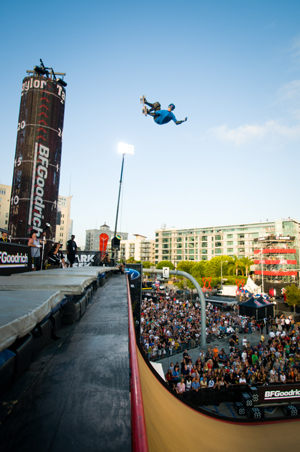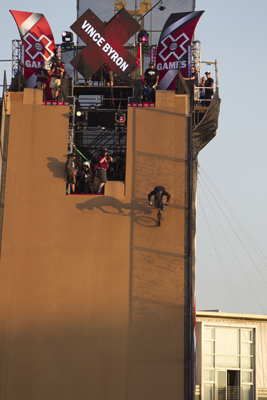To the Edge: Producing and Broadcasting Summer X Games 2011
As a hybrid live/broadcast event, the X Games franchise is the closest thing we have to the Olympics, only better, because ESPN has near-complete control over the events and seems to enjoy taking the "extreme" philosophy at the heart of the games to the limit.
This year's Summer X Games 17 (July 29-31, 2011) made it a little easier on the players and the watchers. Where last year the Los Angeles Memorial Coliseum joined the L.A. Live complex including the Staples Center and the Nokia Theater nearly a mile away to host events like Moto X and skateboarding's Big Air ramp, this year's competition put it all in one place at L.A. Live. That made it a bit easier to manage what has each year become an ever-more-complex live and broadcast production, and this year was no different.
"One of the things that makes X Games shows so interesting it that it's often hard to see where the live production ends and the broadcast begins," observes Ed Johnson, a freelance engineer and systems designer who has been creating the live sound distribution for X Games since 2003, managing the increasingly Hydra-headed connection between being there and being on air. (He does the same for Red Bull's extreme sports shows, so he know this hyperactive and highly aspirational audience well.) But, he quickly adds, he has them well prioritized. "As it was explained to me years ago by Ron Semiao, the inventor of the X Games, it should always be approached first as a live event, like going to concert that just happens to also be broadcast. You have to keep the energy up for the people who are there, but you also have to try to keep it safe for television and not sabotage their show. It's a delicate balance."

A skateboarder competes/performs for the live and broadcast audience
Sound Systems
Examples of that dichotomy are the sound systems around the campus area. There are nine of them, and they have to be loud enough to keep the crowds' and the contestants' energy up, but can't overwhelm the sensitive long-throw shotgun microphones set up along the courses to catch the sound effects for the broadcasts. ESPN distributes its broadcast audio over a large MADI-over-fiber network; that interfaces with the events' live sound and intercom, which is routed through nine Riedel 32- or 64-channel modular Artist M Frames. Using the 24 XLR I/Os on each frame, Johnson has a total of 216 audio I/Os for audio signals across the campus, as well as some used for 4-wire intercom and other line-level audio and program feeds.
When ESPN wants a clip of, for instance, a competition winner being interviewed at a particular event site, Johnson will route voice and left-right music audio signal over to ESPN's truckworld compound via the MADI stream from his Artist M frames. The trucks can return the favor when needed, sending him voice-over and videotape playback from another event venue to show on the video monitors at each other venue during lulls in their action. The mandate is, never a dull moment, on site or on air.

One of many LED Xs used as signage